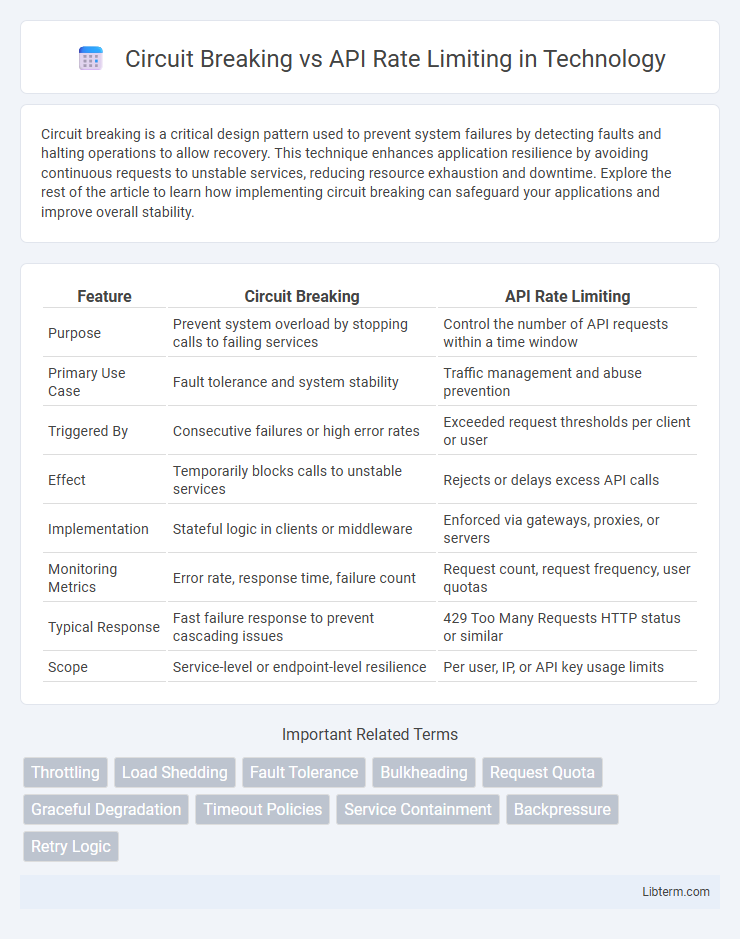Circuit breaking is a critical design pattern used to prevent system failures by detecting faults and halting operations to allow recovery. This technique enhances application resilience by avoiding continuous requests to unstable services, reducing resource exhaustion and downtime. Explore the rest of the article to learn how implementing circuit breaking can safeguard your applications and improve overall stability.
Table of Comparison
| Feature | Circuit Breaking | API Rate Limiting |
|---|---|---|
| Purpose | Prevent system overload by stopping calls to failing services | Control the number of API requests within a time window |
| Primary Use Case | Fault tolerance and system stability | Traffic management and abuse prevention |
| Triggered By | Consecutive failures or high error rates | Exceeded request thresholds per client or user |
| Effect | Temporarily blocks calls to unstable services | Rejects or delays excess API calls |
| Implementation | Stateful logic in clients or middleware | Enforced via gateways, proxies, or servers |
| Monitoring Metrics | Error rate, response time, failure count | Request count, request frequency, user quotas |
| Typical Response | Fast failure response to prevent cascading issues | 429 Too Many Requests HTTP status or similar |
| Scope | Service-level or endpoint-level resilience | Per user, IP, or API key usage limits |
Introduction to Circuit Breaking and API Rate Limiting
Circuit breaking is a resilience pattern designed to detect failures and encapsulate the logic of stopping retries to prevent system overload, thereby maintaining application stability. API rate limiting controls the number of requests a user or client can make to an API within a defined timeframe, ensuring fair resource allocation and preventing abuse. Both techniques optimize system reliability and performance by managing traffic flow and fault tolerance in distributed applications.
Understanding Circuit Breaking: Purpose and Functionality
Circuit breaking is a fault tolerance mechanism designed to detect failures and prevent cascading system crashes by temporarily halting requests to a failing API or service. It monitors the success and failure rates of API calls, opening the circuit to stop requests when failure thresholds are exceeded, then periodically tests the service to determine when to resume traffic. This approach ensures system stability and improves resilience by isolating faulted components and allowing recovery without overwhelming the backend.
What is API Rate Limiting? Key Concepts Explained
API Rate Limiting controls the number of requests a client can make to an API within a specific time frame to prevent server overload and ensure fair resource distribution. Key concepts include request quotas, time windows, throttling, and status codes like HTTP 429 to signal limit breaches. Effective rate limiting protects backend services, improves API stability, and enhances user experience by managing traffic spikes and abuse.
Core Differences Between Circuit Breaking and Rate Limiting
Circuit breaking protects system stability by detecting failures and temporarily halting requests to prevent cascading issues, while API rate limiting controls traffic volume by restricting the number of requests over a specific time frame. Circuit breakers respond dynamically to service health, enabling automatic recovery when conditions improve, whereas rate limiting enforces static thresholds regardless of backend status. These mechanisms address different challenges: circuit breaking mitigates fault propagation, and rate limiting manages resource consumption.
Use Cases for Circuit Breaking in Modern Applications
Circuit breaking is essential in modern applications for preventing cascading failures by temporarily halting requests to a failing service, allowing it time to recover. It is particularly useful in microservices architectures where service dependencies can propagate failures rapidly, ensuring system resilience and stability. Circuit breakers help maintain system responsiveness during latency spikes or partial outages by avoiding repeated calls to unhealthy endpoints.
Common Scenarios for Applying API Rate Limiting
API rate limiting is commonly applied in scenarios involving high traffic volumes to prevent server overload and ensure equitable resource distribution among users. It is essential in protecting APIs from abuse or accidental spikes caused by automated scripts, ensuring stability and consistent performance. Rate limiting is also crucial for managing service tiers, enforcing usage quotas, and safeguarding backend services from excessive requests in microservices architectures.
Benefits and Drawbacks of Circuit Breaking
Circuit breaking prevents system overload by stopping requests to failing services, which improves overall system resilience and protects against cascading failures. However, it may lead to temporary service unavailability, impacting user experience if thresholds are set too aggressively. Fine-tuning breaker parameters requires careful monitoring to balance fault tolerance and service responsiveness.
Pros and Cons of API Rate Limiting
API rate limiting controls the number of client requests to prevent server overload and ensure fair resource distribution, enhancing stability and user experience. Benefits include protection against abuse, improved security, and predictable API performance under traffic spikes. However, strict limits may cause legitimate request blocking, degrade user experience, and require careful threshold tuning to balance availability and resource protection.
Choosing the Right Strategy: Circuit Breaking vs API Rate Limiting
Choosing the right strategy between circuit breaking and API rate limiting depends on the specific use case and system requirements. Circuit breaking is ideal for preventing cascading failures by temporarily halting requests to a failing service, thereby maintaining system stability under fault conditions. API rate limiting focuses on controlling the volume of incoming requests to protect backend resources and ensure fair usage, making it essential for managing traffic and preventing abuse.
Best Practices for Implementation and Monitoring
Circuit breaking prevents system overload by temporarily halting requests when a service is detected as failing, while API rate limiting controls the number of requests to protect backend resources and ensure fair usage. Best practices for implementation include setting dynamic thresholds for circuit breakers based on real-time error rates and latency, and configuring rate limits using token buckets or leaky bucket algorithms tailored to user profiles or endpoints. Effective monitoring involves tracking metrics such as error rates, request counts, response times, and circuit breaker states with tools like Prometheus and Grafana to proactively detect anomalies and adjust configurations.
Circuit Breaking Infographic

 libterm.com
libterm.com